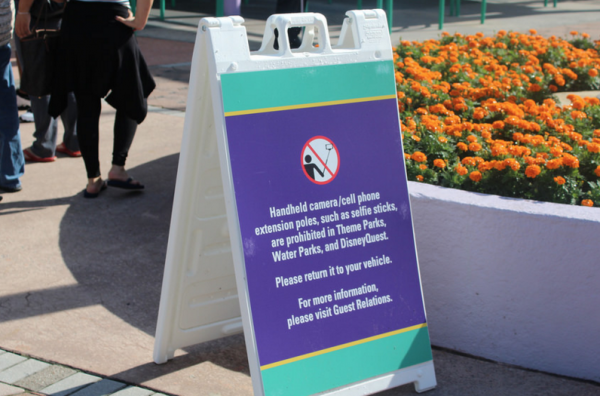Disney today
Many of the early rules for park behavior went away as evolving social dynamics altered the public’s perception of inappropriate activities. Only a few of the early rules still exist, and most of them are modified to demonstrate modern updates to the social contract.
Clothing not optional…
For example, women can and do wear halter tops to parks today. They must, however, wear clothing. Disney theme parks aren’t nudist colonies, and cast members will eject anyone who walks around topless, even men.
One of the infamous examples of Disney’s issues with nudity occurred at Splash Mountain at Disneyland. The vaunted log flume attraction climaxes with a huge plunge straight down into the water below. The idea is that you’ll get somewhere between slightly and extremely wet. In order to save the moment for posterity’s sake (and make a few dollars along the way), Disney installed cameras to capture the expressions of riders during the big fall.
There’s just one problem. Some people are always going to find ways to bring nudity into the situation. A few women, perhaps still lamenting the stringent halter top rules, started to use the cameras as an opportunity to show off their cleavage. Even a family theme park like Disneyland isn’t immune from a bit of exhibitionism. Disney obviously bans guests that they bust for flashing their breasts, but Flash Mountain is still a thing even today.
If you get caught flashing on Splash Mountain, however, you're in a lot of trouble. Disney could throw the book at you for this one. It's technically public indecency, and with small children around, getting banned from the park might not be your biggest concern. The prosecution on this crime could be a felony, not a misdemeanor. You should avoid the temptation to flash on this particular mountain.
Selfie Sticks
In January of 2015, NPR noted that the global trend of selfie sticks was finally arriving in America. These mobile monopods were already ubiquitous in parts of Asia. Global sales are in the tens of millions, and the popularity of the devices has led to a massive debate over the inventor of the device. A man named Wayne Fromm has the patent for the device, which he obtained in 2010. There are sales catalog photos of a selfie stick going back to 1995, however, and someone unearthed an image from 1925 (!) that looks like the same device.
Assuming a TARDIS wasn’t involved, selfie sticks are almost a century old, yet people didn’t notice until a few years ago. Americans took note in late 2014, when over 100,000 people bought selfie sticks over the holiday sales period. That’s a drop in the bucket compared to international sales, but those numbers reflected the ascending American popularity of a global trend. In late 2014 and early 2015, selfie sticks were the Gangnam Style of camera add-ons. Americans were last, but once we got on board, the situation changed.
The problem with selfie sticks is obvious. It’s right there in the name. A stick is a dangerous item in an amusement park in the best of circumstances. If someone foolishly tried to use it on a ride, they run the risk of seriously injuring themselves, others on the ride, and potentially even innocent bystanders nearby.
The rising popularity of selfie sticks placed The Walt Disney Company in an awkward position. They knew that a certain segment of their clients were used to having them. They understood that people want to commemorate their visits to Disney theme parks with personalized images. And they realized that like many trends, selfie sticks could quickly go the way of the Tamagotchi if they ignored the problem long enough.
Alas, too many irresponsible people starting employing selfie sticks. I witnessed this first hand during a May, 2015, visit to Magic Kingdom. A person holding a selfie stick mindlessly wandered directly into the path of float. An attentive cast member jumped in their way and thereby averted catastrophe, but that’s merely one anecdotal example of the perils caused by inattentive selfie stick holders.
At the end of June, Disney had seen enough. They added selfie sticks to the banned list on June 30th at Disneyland and Walt Disney World and on July 1st at Disneyland Paris and Hong Kong Disneyland. Their official statement was powerful in its honest assessment of the problem: “We strive to provide a great experience for the entire family, and unfortunately selfie sticks have become a growing safety concern for both our guests and cast.”
A lot of the reasons why selfie sticks were banned apply to ride videos as well. While smartphone cameras get smaller and more powerful every year, Disney ruled in the early days of the technology that carrying a recording device on a ride was a bad idea. They had a hidden agenda in doing so.
Some of the technology employed in Disney’s attractions includes copyrighted material. At the time they decided to ban videos, they didn’t own all of this material, either. A good example is Star Tours, which Disney eventually purchased from George Lucas when they acquired LucasFilm in 2012.
If someone recorded the special material created by LucasFilm for the attraction, Disney was culpable. The two companies had too strong a relationship for that concern to create financial friction, but it was a possibility. Primarily, Disney wants to protect its intellectual property as much as possible. Strangers taking videos doesn’t fit that plan, so they’re theoretically strict about all recording devices.
Today, it’s largely a non-issue. If you try to record at a Disney theme park, you won’t get banned even if it’s technically a possibility. The primary exception is if you do something egregious that interferes with the enjoyment of a fellow guest. Otherwise, smartphone cameras are a way of life, and Disney understands that attraction videos are functionally free advertising for their marvelous themed rides. If a cast member ever asks you to stop recording, however, do what they say. You are technically breaking the rules, after all.





Comments
Re: Watch your language. I have gotten a laugh quite a few times on the parking lot trams when they pull up to the entry gates. Sometimes there will be cast member with a quick wit (or is it part of the spiel now?) will remark, "Please lower your heads and watch your step. If you fail to do so, please lower your voice and watch your language!" That kind of snarky humor is right up my alley!
Disney does not "offer gay days"
It is a unofficial event.
yes, and it says such in the article
Isn't posting videos of exploring abandon or closed places at Disney banned?